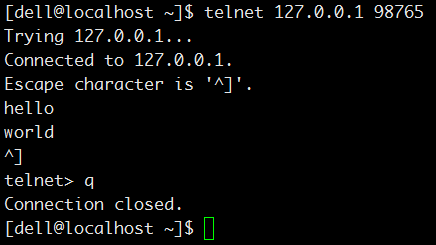epoll测试实例
|
1
2 3 4 5 6 7 8 9 10 11 12 13 14 15 16 17 18 19 20 21 22 23 24 25 26 27 28 29 30 31 32 33 34 35 36 37 38 39 40 41 42 43 44 45 46 47 48 49 50 51 52 53 54 55 56 57 58 59 60 61 62 63 64 65 66 67 68 69 70 71 72 73 74 75 76 77 78 79 80 81 82 83 84 85 86 87 88 89 90 91 92 93 94 95 96 97 98 99 100 101 102 103 104 105 106 107 108 109 110 111 112 113 114 115 116 117 118 119 120 121 122 123 124 125 126 127 128 129 130 131 132 133 134 135 136 137 138 139 140 141 142 143 144 145 146 147 148 149 150 151 152 153 154 155 156 157 158 159 160 161 162 163 164 165 166 167 168 169 170 171 172 173 174 175 176 177 178 179 180 181 182 183 184 185 186 187 188 189 190 191 192 193 194 195 196 197 198 199 200 201 202 203 204 205 206 207 208 209 210 211 212 213 214 215 216 217 218 219 220 221 222 223 224 225 226 227 228 229 230 231 232 233 234 235 236 237 238 239 240 241 242 243 244 245 246 247 248 249 250 251 252 253 254 255 256 257 258 259 260 261 262 263 264 265 266 267 268 269 270 271 272 273 274 275 |
#include <stdio.h>
#include <stdlib.h> #include <string.h> #include <sys/types.h> #include <sys/socket.h> #include <netdb.h> #include <unistd.h> #include <fcntl.h> #include <sys/epoll.h> #include <errno.h> static int flags = fcntl (sfd, F_GETFL, ); flags |= O_NONBLOCK; ; static int memset (&hints, , sizeof (struct addrinfo)); s = getaddrinfo (NULL, port, &hints, &result); for (rp = result; rp != NULL; rp = rp->ai_next) s = bind (sfd, rp->ai_addr, rp->ai_addrlen); close (sfd); if (rp == NULL) freeaddrinfo (result); return sfd; int ) sfd = create_and_bind (argv[]); s = make_socket_non_blocking (sfd); s = listen (sfd, SOMAXCONN); efd = epoll_create1 (); event.data.fd = sfd; /* Buffer where events are returned */ /* The event loop */ n = epoll_wait (efd, events, MAXEVENTS, -); else if (sfd == events[i].data.fd) in_len = sizeof in_addr; s = getnameinfo (&in_addr, in_len, /* Make the incoming socket non-blocking and add it to the event.data.fd = infd; ) count = read (events[i].data.fd, buf, sizeof buf); /* Write the buffer to standard output */ if (done) /* Closing the descriptor will make epoll remove it free (events); close (sfd); return EXIT_SUCCESS; |
具体函数介绍请参考:https://banu.com/blog/2/how-to-use-epoll-a-complete-example-in-c/
运行结果:
服务器端:

客户端:

epoll测试实例的更多相关文章
- JMeter学习-026-JMeter 分布式(远程)参数化测试实例
以前文所述对文章详情的HTTP请求进行性能测试为例.日常实际场景中,不可能所有的人都在同时访问一篇文章,而是多人访问不同的文章,因而需要对文章编号进行参数化,以更好的模拟日常的性能测试场景.同时,因文 ...
- webservice测试实例
webservice测试实例(LR8.1) 接口声明:这个接口是sina的短信服务接口,我只是用来做脚本学习使用,不会对其产生压力:希望读者也只是用来进行录制学习,而不是产生压力. 接口文档:http ...
- [原]在Fedora中编译Libevent测试实例
在我的昨天的博文<[原]我在Windows环境下的首个Libevent测试实例>中介绍了在Windows环境下如何编译一个echo server例子.今天我又试了一下在Linux环境中编译 ...
- C++动态链接库测试实例
前话 上一章节我导出了一个动态链接库 要使用该链接库,我们还需要该链接库对外公开的函数,即头文件 下面开始实例 测试实例 第一步--将动态链接库的dll.lib.和头文件导入项目中 文件目录如下: 项 ...
- Linux下简易蜂鸣器驱动代码及测试实例
驱动代码: #include <linux/module.h> #include <linux/kernel.h> #include <linux/init.h> ...
- 微服务架构 - 离线部署k8s平台并部署测试实例
一般在公司部署或者真实环境部署k8s平台,很有可能是内网环境,也即意味着是无法连接互联网的环境,这时就需要离线部署k8s平台.在此整理离线部署k8s的步骤,分享给大家,有什么不足之处,欢迎指正. 1. ...
- WinForm中 Asp.Net Signalr消息推送测试实例
p{ text-align:center; } blockquote > p > span{ text-align:center; font-size: 18px; color: #ff0 ...
- Confluence 6 从生产环境中恢复一个测试实例
请参考 Restoring a Test Instance from Production 页面中的内容获得更多完整的说明. 很多 Confluence 的管理员将会使用生产实例运行完整数据和服务的 ...
- Rabbit简单测试实例
Rabbit简单测试实例 安装环境: Yum -y install python-pip Pip install pika 生产者 1 2 3 4 5 6 7 8 9 10 11 import pik ...
随机推荐
- bzoj 1539: [POI2005]Dwu-Double-row
假设一列交换表示为1,不换表示为0. 身高相同的两个人相当于给其中两列了一个限制条件,要么是两个必须相等,要么一个为零一个为一. 有了关系后我们就可以把每列当成一个点建边,边权为0表示必须相同,1为必 ...
- 使用JS在textarea在光标处插入内容
// 在光标处插入字符串 // myField 文本框对象 // myValue 要插入的值 function insertAtCursor(myField, myValue) { //IE supp ...
- 团体程序设计天梯赛 L3-012. 水果忍者
/*对于一条满足条件的直线,向下移,直到触碰一条线段的下端点,仍然经过其它线段,该直线仍然满足条件 即以一条线段的下(上)端点作为直线上的一点,求为了经过一条线段的最小.最大斜率值(mink,maxk ...
- 非极大值抑制Non-Maximum Suppression(NMS)
非极大值抑制(Non-Maximum Suppression,NMS) 概述 非极大值抑制(Non-Maximum Suppression,NMS),顾名思义就是抑制不是极大值的元素,可以理解为局 ...
- 1130 N的阶乘的长度 V2(斯特林近似)
1130 N的阶乘的长度 V2(斯特林近似) 基准时间限制:1 秒 空间限制:131072 KB 分值: 0 难度:基础题 收藏 关注 输入N求N的阶乘的10进制表示的长度.例如6! = 720, ...
- HDU 1525 类Bash博弈
给两数a,b,大的数b = b - a*k,a*k为不大于b的数,重复过程,直到一个数为0时,此时当前操作人胜. 可以发现如果每次b=b%a,那么GCD的步数决定了先手后手谁胜,而每次GCD的一步过程 ...
- php设计模式-工厂设计模式
概念: 工厂设计模式提供获取某个对象的新实例的一个接口,同时使调用代码避免确定实际实例化基类步骤. 很多高级模式都是依赖于工厂模式.
- windows环境下git的环境变量配置
1.从官网下载git这个软件.msi格式,然后安装. 2.找到你的git的安装目录,并记录下来 3.配置环境变量:在path里加入—— ;你的git的安装目录\bin;你的git的安装目录\libe ...
- JS模块规范
ES6标准发布后,module成为标准,标准的使用是以export指令导出接口,以import引入模块,但是在我们一贯的node模块中,我们采用的是CommonJS规范,使用require引入模块,使 ...
- GRUB (简体中文)
原文链接:https://wiki.archlinux.org/index.php/GRUB_(%E7%AE%80%E4%BD%93%E4%B8%AD%E6%96%87) 前言 引导程序是计算机启动时 ...
